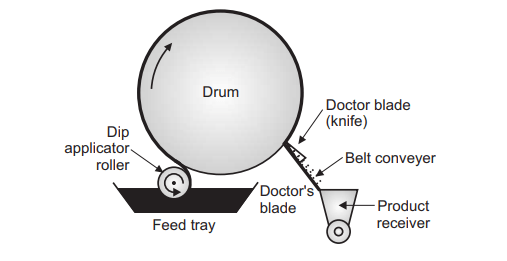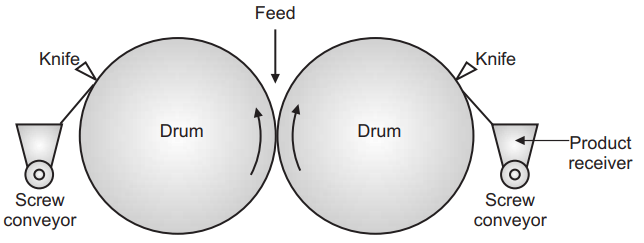The drum dryer has been used since a long time for drying sheets of paper or cloth and, more recently, for drying liquids and pastes. Drum dryers in general and the various types of drum dryers (atmospheric single drum, vacuum single-drum, and the double-drum dryers) in particular are selected or rejected for any given drying requirement on the basis of their individual operating characteristics and costs.
Table of Contents
Principle of the drum dryer
Drum dryers operate by applying a thin layer of the product to be dried to the outside of a rotating drum. The drum is internally heated by steam which quickly evaporates any liquid from the product. After almost one full revolution the remaining dried material is removed from the drum by a knife as a film or powder.
Construction of drum dryer
Drum dryer is a moving bed dryer. The unit is constructed from cast iron and stainless steel, providing cleanliness and resistance to chemical attack. The drums are engineered with hard chrome plating or chrome plated over nickel to ensure maximum heat transfer and to accommodate high steam temperatures and pressures, precision machined to provide maximum and reproducible heat transfer throughout its life. The drums are hollow horizontally mounted 0.6 to 3.0 meter in diameter and 0.6 to 4.0 meter in length, whose external surface is smoothly polished. Steam or heating coils can be used inside the drum for heat generation. Heat is transferred by conduction to the material that can be controlled with a thermostat. Drum is rotated with a motor device at 1-10 r.p.m.

Double drum dryer
Extra capacity can be provided by using a double drum dryer. A double drum dryer is also called a dual drum and is often used for products with low to medium viscosity. In this system, the product is fed into a pool between the two drums, which always turn in opposite directions. The small space between the drums can be set accurately so that the desired film layer can be obtained. Other combinations are possible depending on the product and the desired end result.

Vacuum drum dryer
A drum dryer that operates under vacuum allows the product to be dried at lower temperatures. These drum dryers provide a higher capacity and less product loss under vacuum. Two steam-heated drums turn in an air-tight casing under a high vacuum. The liquid is fed between the drums from the top, dried, and scraped off before the drums have fully rotated. There is no accumulation of product residues and no recirculation of the material. The drum dryer is easily accessed for inspection and maintenance. There is a wide range of applications, including damage prevention to heat-sensitive product components or evaporation of solvents at low temperatures. The vapors collected are condensed elsewhere. The absence of atmospheric pollution and climatic conditions gives reproducible product quality. Feed materials can benefit from such careful treatment. Evaporation takes place within a few seconds without risk of oxidation. Thermolabile materials such as enzymes and proteins are preserved and blockage of proteins is prevented. The end product can be dissolved easily into a liquid. Chemical products, too, can be processed in the dryer by using a vacuum process and undergo drying treatment. It can use a gas such as nitrogen to keep the environment inert.
Accessories: Dryers for pharmaceutical applications are generally provided with a vapor canopy and extract system to remove the vapors from the operating area. Dryers for hazardous materials may be provided with complete dust and fume-tight enclosures.
Drying equipment
Working of drum Dryer
Single drum dryer
The robust construction of drum dryers made them to be used efficiently over last 60 years and still are in use today. The drum body of the drum dryer is heated on the inside by steam. Steam heating gives a uniform temperature distribution over the drum surface to provide consistent product quality. The steam condenses on the inside of the drying drum. The condensate is continuously removed from the drum so that the largest possible surface area remains available on the inside of the drum for condensation of the steam. The steam system is a closed system, which means that the product cannot come into contact with the steam or condensate. Depending on the design of the drum dryer, the product is applied continuously as a thin film on the underside or top of the main drum. As the drum turns it is heated on the inside and the product dries on the outside of the drum dryer. The short exposure to a high temperature reduces the risk of damage to the product. The water or solvent evaporates and leaves from the surface of drum. If necessary, the vapor can also be suctioned-off locally around the drum. The dried product layer finally reaches the knife and is scraped-off.
Double drum dryer
The liquid to be dried is fed into the valley created by the two drums, where it is applied to the drums as they rotate together. The dry product is removed by a knife on each drum. Wet materials are completely dried during slightly less than one rotation from one side to another side of the drum. Dried materials are scrapped by a knife, which then falls into a product receiver. Contact time of the material with hot metal is 6 to 15 seconds only. Therefore, processing conditions such as film thickness and drum temperature are closely monitored and controlled. The shaft-mounted main drive speed is adjusted by electronic inverter in the control panel. The liquid or paste material present in the feed pan adheres as a thin layer to the external surface of the drum during its rotation.
Product Removal
Product is removed from the drum dryer surface by means of an alloy steel doctor blade or knife rigidly clamped in a cast iron knife bar assembly. The knife is applied to the surface of the drum by pneumatic cylinders located at each end of the dryer. For improved knife life and reduced drum maintenance an oscillating knife system is fitted with either conventional or disposable knives. After removal from the drum the product is collected by a transverse screw conveyor specially designed to break up the product film or flakes into easy-to-handle particles. For products that may require cooling after removal from the drum air.
Advantages
(i) Drum dryer gives a rapid (few seconds) drying and its mass transfer rate is higher.
(ii) The entire material is continuously exposed to uniform heat. This process is characterized by short drying time and minimum product heating.
(iii) The equipment is compact 100% closed system and tailored models are available.
(iv) Their simple operation makes them run with the minimum of training and require no specialist maintenance.
(v) Drum dryers are economical with cheap installation and 24 hour a day continuous production.
(vi) It can have vacuum facilities to prevent dust emission thereby giving a guarantee of optimal hygiene during the complete production process.
(vii) This dryer work with minimum energy consumption and does not require large dust recovery systems such as filters.
(viii) The heat is transferred by steam to the (metal) wall, which in turn transfers it to the product on the other side of the wall. All the heat transferred by the wall is used to dry the product and does not leave the machine or chimney unused making this dryer a much more efficient process.
(ix) Using these dryers product supply can be controlled. Furthermore, drums create a kneading effect that prevents the formation of lumps in sticky products.
(x) A perfect distribution over the entire length of the drum makes the system ideal for processing doughy or pasty products.
(xi) The temperature of the drum can be controlled independently for the required drying task by setting the steam pressure and thus are best suited for processing certain heat-sensitive products,
Disadvantages
(i) The operating conditions are critical and need to be monitored.
(ii) Skilled operators are needed to control feed rate, film thickness, speed of rotation and temperature.
(iii) It is not suitable for low concentration solutions or suspensions of low viscosity.
Applications of drum Dryer
(i) Drum dryer is used in the drying of liquids and pastes of sticky and highly viscous products.
(ii) It is used under vacuum for drying temperature-sensitive products such as vitamins, proteins, yeasts, pigments, malt extracts, hormones, and antibiotics.
(iii) It has a closed process area that protects the product and/or the environment.
(iv) Drum dryer is used for drying solutions, slurries, suspensions, etc.
(v) Used to dry products such as starch products, ferrous salts, suspensions of zinc oxide, suspension of kaolin, calcium, insecticides, barium carbonates, etc.
(vi) Vacuum drum drying is used for instant beverages, chocolate products, chemicals and recovery of solvents, foods and beauty soaps, etc.